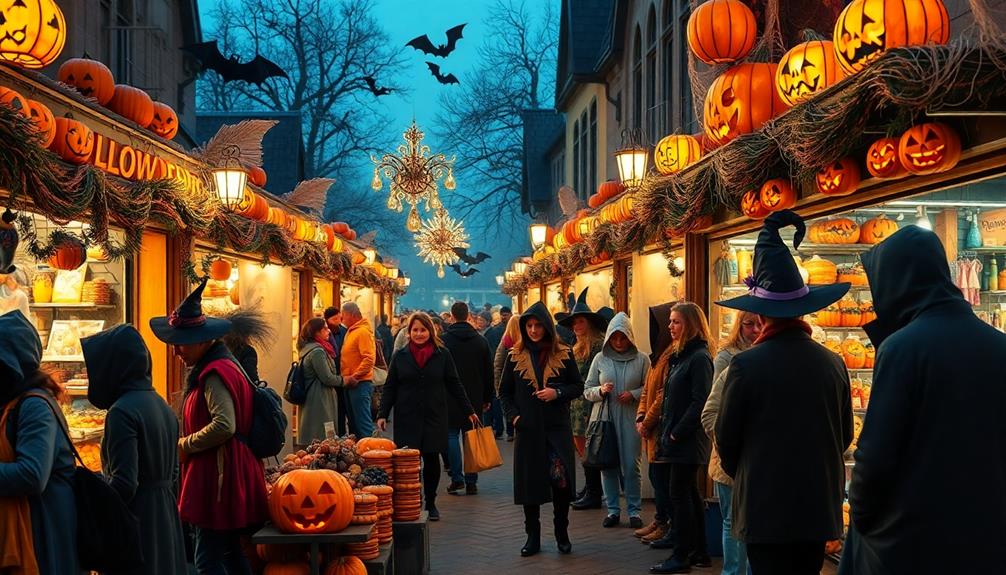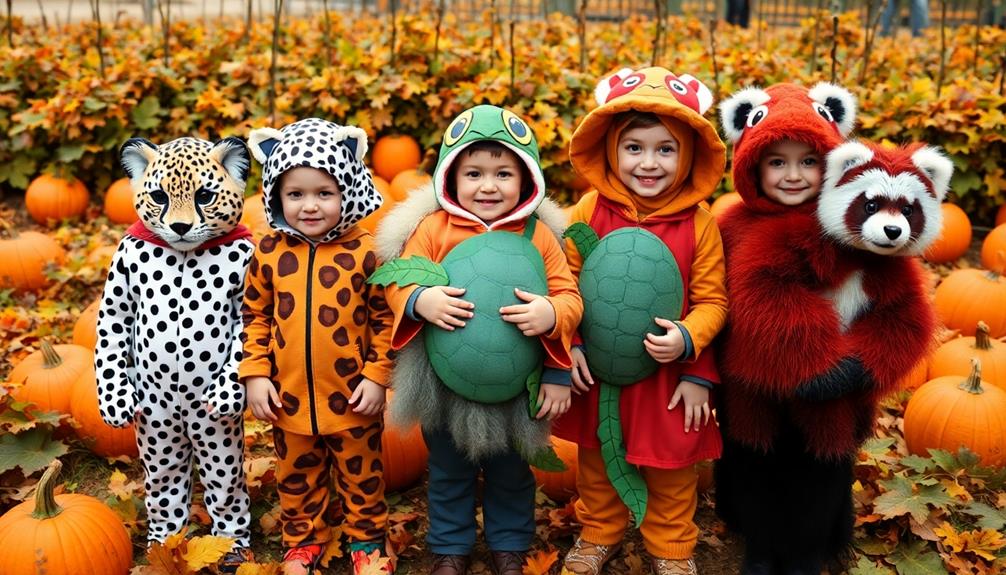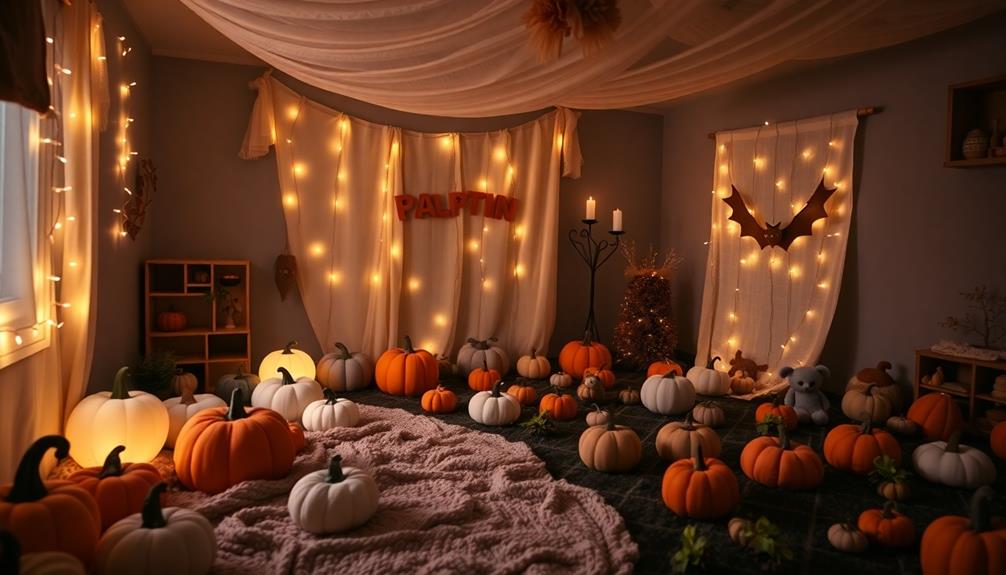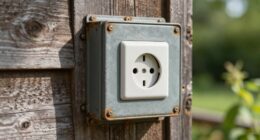Halloween's economic impact is significant, with U.S. consumers expected to spend around $12.2 billion in 2025. Costumes alone make up $3.2 billion of that spending, while candy sales reach about $2.7 billion. You'll see an increase in seasonal job opportunities as retailers hire extra staff to handle the rush. More than 100,000 temporary positions are created annually, boosting local economies. Online shopping is booming, reflecting a growing trend towards convenience. With the entertainment industry also capitalizing on the spooky season, the Halloween business continues to flourish. Stick around to uncover even more fascinating insights about this vibrant industry.
Key Takeaways
- Halloween spending in the U.S. is projected to reach $12.2 billion in 2025, with costumes and candy being major expenditure categories.
- Nearly 50% of consumers begin shopping for Halloween in September or earlier, indicating a shift towards earlier seasonal spending.
- Seasonal hiring generates around 100,000 temporary jobs annually, boosting local economies in retail and entertainment sectors.
- Online shopping for Halloween has surged by 40%, reflecting consumers' preference for convenience and access to a wider range of products.
- Consumers are increasingly prioritizing sustainability, with 40% seeking eco-friendly Halloween products, including reusable costumes and recycled decorations.
Economic Impact of Halloween
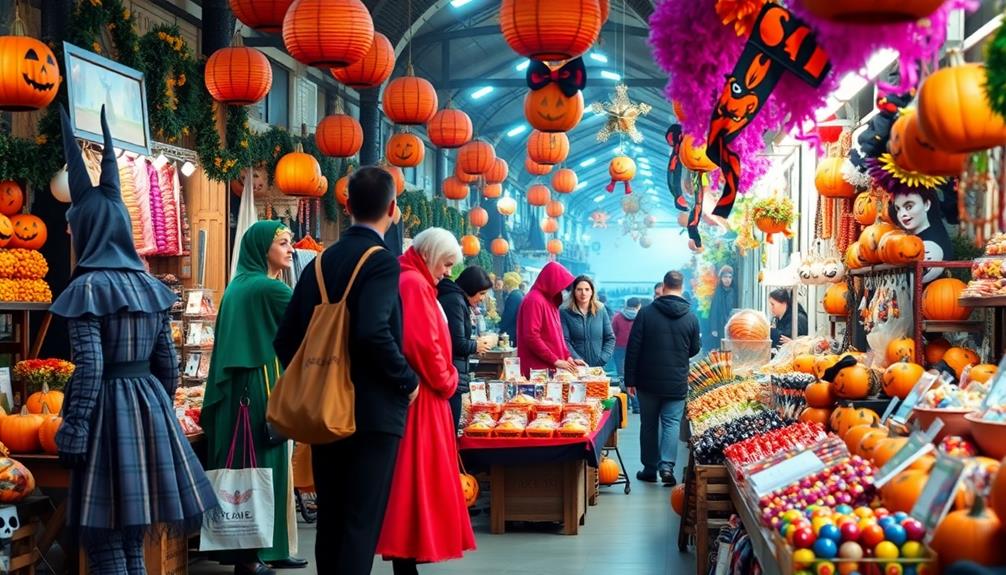
Halloween's economic impact is nothing short of impressive, with spending in the U.S. projected to hit $12.2 billion in 2025. This substantial amount underscores how essential Halloween spending is to the retail landscape, making it a major event for retailers across the country.
You'll see that about $3.2 billion of this total is spent on costumes alone, showcasing the significance of this category in driving sales. The creativity involved in DIY costume options further stimulates consumer engagement and spending.
Candy sales, which account for around $2.7 billion annually, reflect strong consumer demand for seasonal treats, while home décor spending is estimated at $2 billion, indicating a robust market for themed decorations.
This surge in economic activity doesn't just benefit retail stores; it also creates job opportunities. Seasonal events and haunted attractions spring up in various regions, leading to increased tourism and further job creation.
As Halloween approaches, you'll notice how local economies thrive, fueled by your festive purchases and activities. The combined effects of Halloween spending not only bolster businesses but also foster community engagement, making this holiday a crucial contributor to economic growth.
Retail Trends and Spending
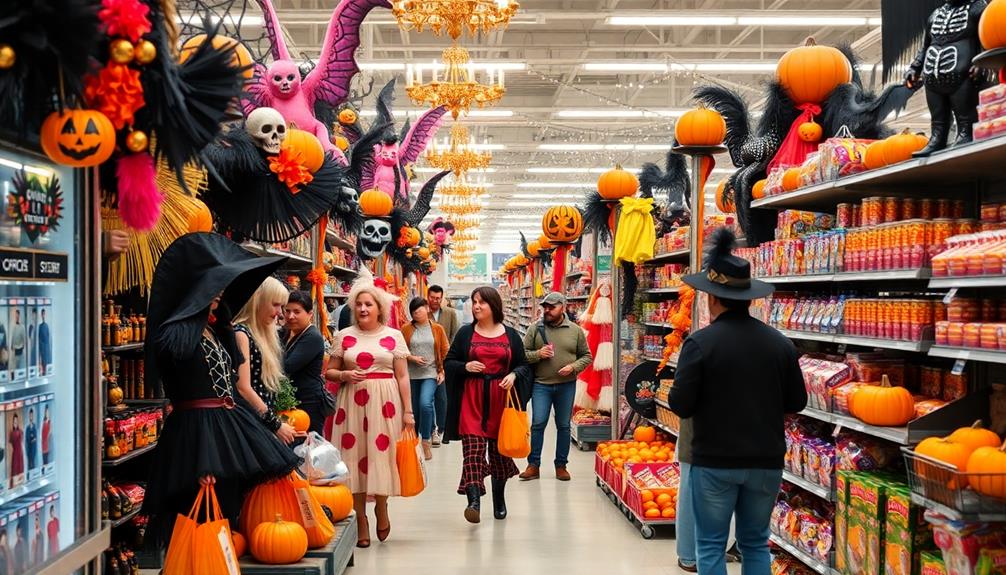
As you gear up for Halloween, you'll notice a shift in shopping patterns, with many starting their purchases as early as September.
This season, teens are particularly drawn to costumes like the DC Superheroes Supergirl Teen Costumes for a heroic look.
Retailers are capitalizing on this trend, ramping up their costume and decoration sales to meet the demand.
With spending projected to hit $12.2 billion this year, it's clear that Halloween is a significant retail event you won't want to miss.
Seasonal Shopping Patterns
With Halloween just around the corner, seasonal shopping patterns are shifting remarkably. In 2025, consumer spending for Halloween is projected to hit an impressive $12.2 billion, with each shopper spending an average of $108.24. This surge reflects a strong interest in Halloween, and nearly half of consumers planned to start their shopping in September or earlier.
This shift towards earlier purchases indicates that you're not alone in wanting to get a jump on the season. Retailers are benefiting considerably from this trend, often experiencing a 20-30% increase in sales during this festive season. One-third of U.S. shoppers are getting their Halloween essentials just 3-4 weeks prior to the holiday, emphasizing the urgency many feel.
Additionally, online shopping has surged by 40% in recent years, showcasing a considerable trend toward digital retail that caters to your convenience. Major retailers like Walmart and Target are capitalizing on these patterns by expanding their seasonal product offerings and launching temporary stores and promotions.
This creates not only shopping opportunities for you but also seasonal jobs for those looking to earn extra income during the Halloween rush.
Costume and Decoration Sales
Costume and decoration sales are soaring this season, reflecting a vibrant enthusiasm for Halloween festivities. In 2025, costumes alone accounted for over $3 billion of total Halloween spending, making it the largest segment of expenditures.
You're not alone if you're planning to wear a costume this year—approximately 47% of consumers are joining in on the fun. There's a notable trend toward pet costumes, with 17% of shoppers looking to outfit their furry friends.
Retailers like Walmart and Target are quick to capitalize on this excitement, expanding their seasonal product offerings and launching Halloween merchandise displays as early as September. This strategy helps them capture early-bird shoppers keen to embrace the holiday spirit.
Home décor spending has also seen a significant boost, estimated at $2 billion in 2025. Popular items include spooky yard decorations and themed lighting, which enhance the festive atmosphere.
Seasonal Employment Opportunities
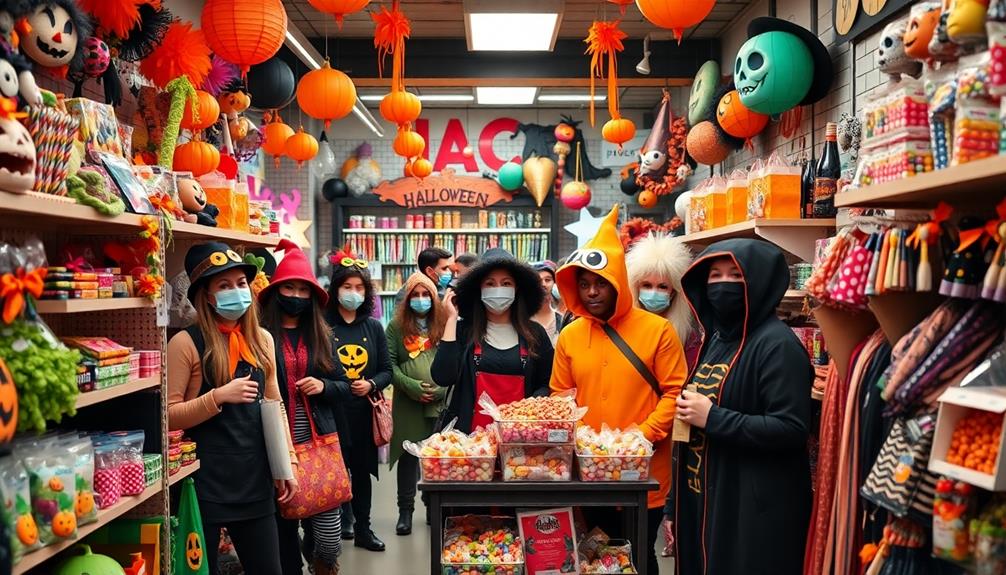
Halloween isn't just about costumes and candy; it creates around 100,000 temporary jobs each year.
This surge in employment opportunities is essential for local economies, especially as Mothers Day 2025 approaches, leading to increased retail activity.
As retailers and entertainment venues ramp up hiring, you'll find plenty of opportunities in sales, acting, and support roles.
This seasonal surge in demand can be a great way for students and part-time workers to earn some extra cash.
Job Creation Statistics
The Halloween season sparks a surge in temporary job opportunities, creating around 100,000 positions across various industries. Retailers ramp up hiring to meet the increased demand for costumes, decorations, and party supplies. You'll find positions like salespeople, costume designers, and event planners popping up everywhere.
Haunted attractions and seasonal events also contribute to job creation, especially in states like Arizona, which alone estimates up to 5,000 temporary roles in acting and design. Temporary stores specializing in Halloween merchandise often spring up, providing seasonal employment that benefits local communities.
These seasonal jobs are especially appealing to part-time workers and students. With 73% of consumers planning to celebrate Halloween, the demand for labor continues to grow.
Here's a quick look at some key sectors for Halloween job creation:
| Sector | Number of Jobs | Typical Positions |
|---|---|---|
| Retail | 70,000 | Salespeople, Cashiers |
| Entertainment | 20,000 | Actors, Event Coordinators |
| Logistics | 10,000 | Warehouse Staff, Delivery |
With such diverse opportunities, the Halloween season clearly plays a key role in job creation and seasonal employment.
Seasonal Hiring Trends
Every year, seasonal hiring trends see a noticeable uptick as businesses gear up for the Halloween rush. With approximately 100,000 seasonal employment opportunities created, there's a significant demand across various sectors.
Retail stores are particularly active during this time, hiring extra staff to handle the surge in customer traffic, especially in costume and decoration sales, including trending options like Halloween costume ideas.
Haunted attractions also contribute to seasonal hiring, requiring additional personnel for roles like actors, ticket sales, and maintenance. This leads to a spike in temporary job listings, offering many short-term positions suitable for those looking to earn some extra cash.
Specialty Halloween stores often pop up for the season, bringing in workers solely for the Halloween period before closing down after the holiday.
Moreover, the boost in seasonal employment doesn't just stop at retail and entertainment. It extends to logistics and delivery services, reflecting the broader economic impact of the holiday.
Industry Demand Surge
As the spooky season approaches, a noticeable surge in industry demand creates a wealth of seasonal employment opportunities. Halloween generates around 100,000 temporary job opportunities across various sectors, particularly in retail, entertainment, and hospitality.
Retail stores often ramp up their staffing to handle the increased foot traffic, which can lead to a 20-30% spike in sales during this time.
You'll find that haunted attractions and event venues also require extra hands, contributing to substantial seasonal employment in the entertainment industry.
Costume manufacturers boost production to meet the high demand for costumes, leading to temporary factory jobs as well.
This seasonal hiring surge is especially beneficial for part-time workers and students, offering them a chance to earn extra income during the Halloween period.
The impact of this demand extends beyond just immediate job creation; it fosters a vibrant economy that thrives on seasonal festivities.
If you're looking for a way to make some quick cash and gain work experience, now's the perfect time to seek out these temporary job opportunities.
The Halloween industry not only celebrates the spooky but also opens doors for many enthusiastic job seekers.
Consumer Behavior Insights
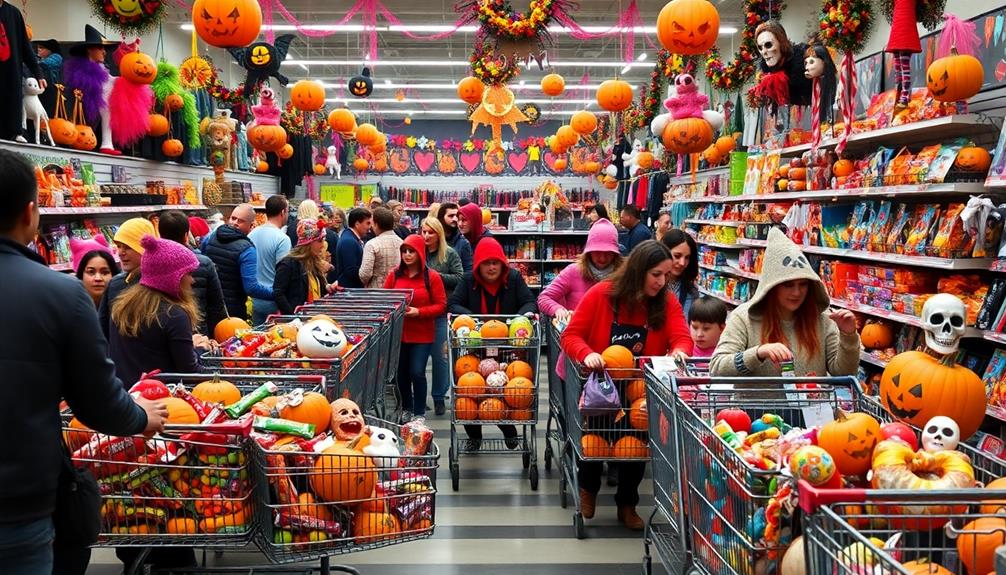
With Halloween creeping up earlier each year, consumer behavior is evolving in fascinating ways. In 2025, nearly half of you planned to kick off your Halloween shopping in September or earlier. This trend toward advance planning shows how important the holiday has become, with the average expenditure per consumer projected at $108.24.
Budgeting strategies can help you make the most of this spending, ensuring that you enjoy the holiday without overspending. One-third of U.S. shoppers are even starting their Halloween shopping 3-4 weeks before the big day, reflecting a clear pattern of early holiday engagement.
The shift towards online shopping is another significant change in consumer behavior. In recent years, online purchases for Halloween have surged by 40%, indicating that more of you prefer the convenience of digital shopping.
This evolution in purchasing habits isn't just a fad; retailers often experience a 20-30% increase in sales during the Halloween season compared to other times of the year. This highlights how economic conditions influence your holiday spending, driving many to embrace both early shopping and online options.
As you prepare for Halloween, understanding these trends can help you make the most of your shopping experience while enjoying the festivities.
Entertainment Industry Influence
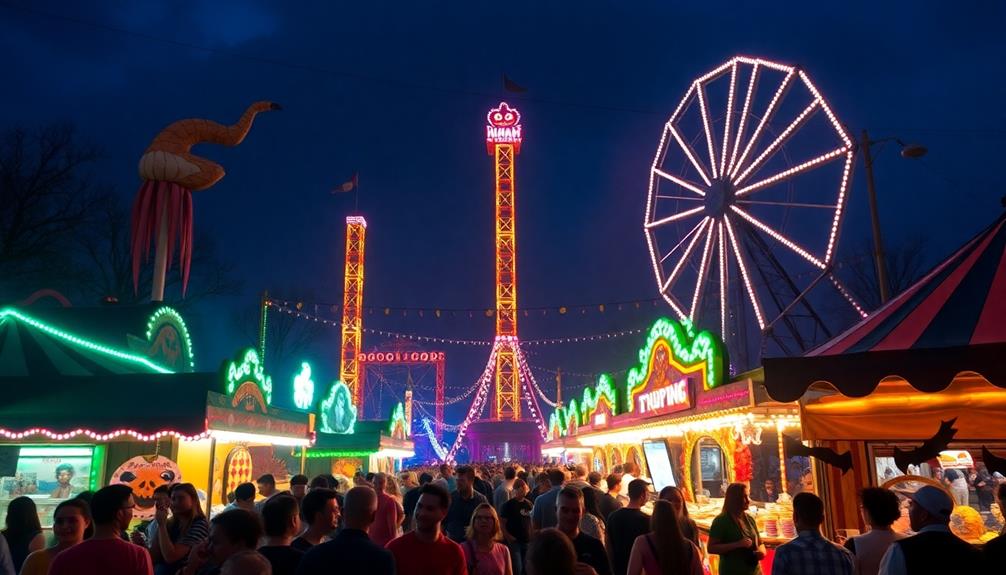
Halloween sparks a surge of creativity in the entertainment industry, transforming how you experience the season. Major studios capitalize on this festive spirit by releasing horror movies and Halloween-themed TV episodes right before the holiday, ensuring you've got plenty of spooky content to choose from.
Cruise destinations also adapt, offering themed activities that enhance the spooky atmosphere for travelers. Streaming platforms also get in on the action, curating special collections of horror films and Halloween specials that draw you in with their eerie allure.
Music platforms notice a similar trend, as Halloween-themed playlists see a significant bump in plays, showcasing the holiday's impact on music consumption. Advertisers strategically target this high traffic, enhancing brand visibility with themed promotions during Halloween streaming events, making it a win-win for both consumers and brands.
Gaming's also part of the mix, with popular titles like Phasmophobia and Dead by Daylight seeing increased player activity. These games often roll out special Halloween-themed content, making your gaming experience even more immersive.
Environmental Considerations
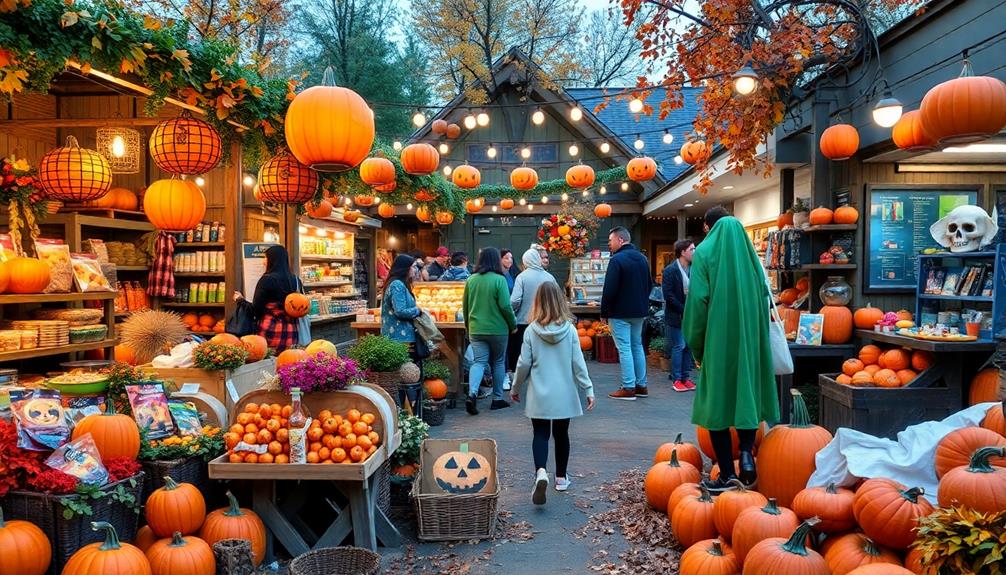
Amidst the excitement of costumes and decorations, environmental considerations are increasingly coming to the forefront of Halloween celebrations. With Halloween generating significant waste—over 2,000 tons of plastic from costumes in the UK alone—it's essential to rethink how you celebrate. Many consumers are now actively seeking sustainable options, reflecting a growing awareness of the environmental impact of single-use products.
Here's a quick look at some eco-friendly alternatives:
| Eco-Friendly Options | Benefits |
|---|---|
| Reusable Costumes | Reduces waste year after year |
| Rentals | Cost-effective and sustainable |
| Upcycled Decorations | Creative and unique |
| Recycled Materials | Less plastic in landfills |
| Natural Pumpkins | Compostable |
Brands like Pottery Barn are responding to this shift by offering eco-friendly decorations made from recycled materials. Approximately 40% of you are now looking for sustainable options when shopping, which further encourages businesses to address waste and adopt greener practices. By choosing recycling and sustainable products, you can enjoy Halloween while minimizing your environmental impact.
Future Outlook and Predictions

As consumers increasingly prioritize sustainable practices, the future of Halloween looks promising, with spending projected to exceed $12 billion in 2025. This figure matches last year's spending, indicating stable demand for Halloween-related products and experiences. Americans spent approximately $3.2 billion on costumes alone, reinforcing the enduring popularity of themed attire across various industries.
The shift towards online shopping is significant, with a 40% surge in digital purchases for Halloween in recent years. This trend reflects changing consumer behavior, which businesses should embrace to maximize their reach during the season.
Additionally, the projected increase of about 100,000 temporary jobs indicates strong consumer engagement and the holiday's economic impact.
Here's what to expect in the coming years:
- Continued growth in Halloween spending driven by cultural significance.
- Enhanced online shopping experiences to cater to consumer preferences.
- Expansion of sustainable product lines as eco-consciousness rises.
- Increased seasonal employment opportunities across various industries.
Frequently Asked Questions
What Is the Economic Impact of Halloween?
Halloween's economic impact's immense, with billions spent on costumes, candy, and decorations. You'll find temporary jobs surge, and retailers thrive, proving this spooky season isn't just about fun—it's a significant boost for the economy.
What Industries Are Most Affected by Halloween?
Did you know consumers are expected to spend around $10 billion on Halloween in 2025? Retail, entertainment, tourism, gaming, and marketing industries thrive during this season, each capitalizing on the holiday's festive spirit and consumer enthusiasm.
What Are the 4 Biggest Expenditures for Halloween?
You'll find the four biggest Halloween expenditures are costumes, candy, home décor, and greeting cards. Each year, you spend considerably on these items, enhancing your festive spirit and celebrating the holiday with style.
How Big of an Industry Is Halloween?
Halloween's a massive industry, generating around $12.2 billion in the U.S. alone. You'll find costumes, decorations, and festivities driving this growth, while online shopping and seasonal jobs further boost the holiday's economic impact.
Conclusion
As Halloween approaches, it's fascinating how this spooky season intertwines with our everyday lives. You might find yourself picking out costumes, indulging in pumpkin-flavored treats, or even enjoying a horror movie marathon. All these little joys contribute to a booming economy, creating jobs and sparking creativity. So, as you celebrate, remember you're part of a larger trend, shaping the future of Halloween. Enjoy the thrills and chills, knowing you're fueling this vibrant celebration!
